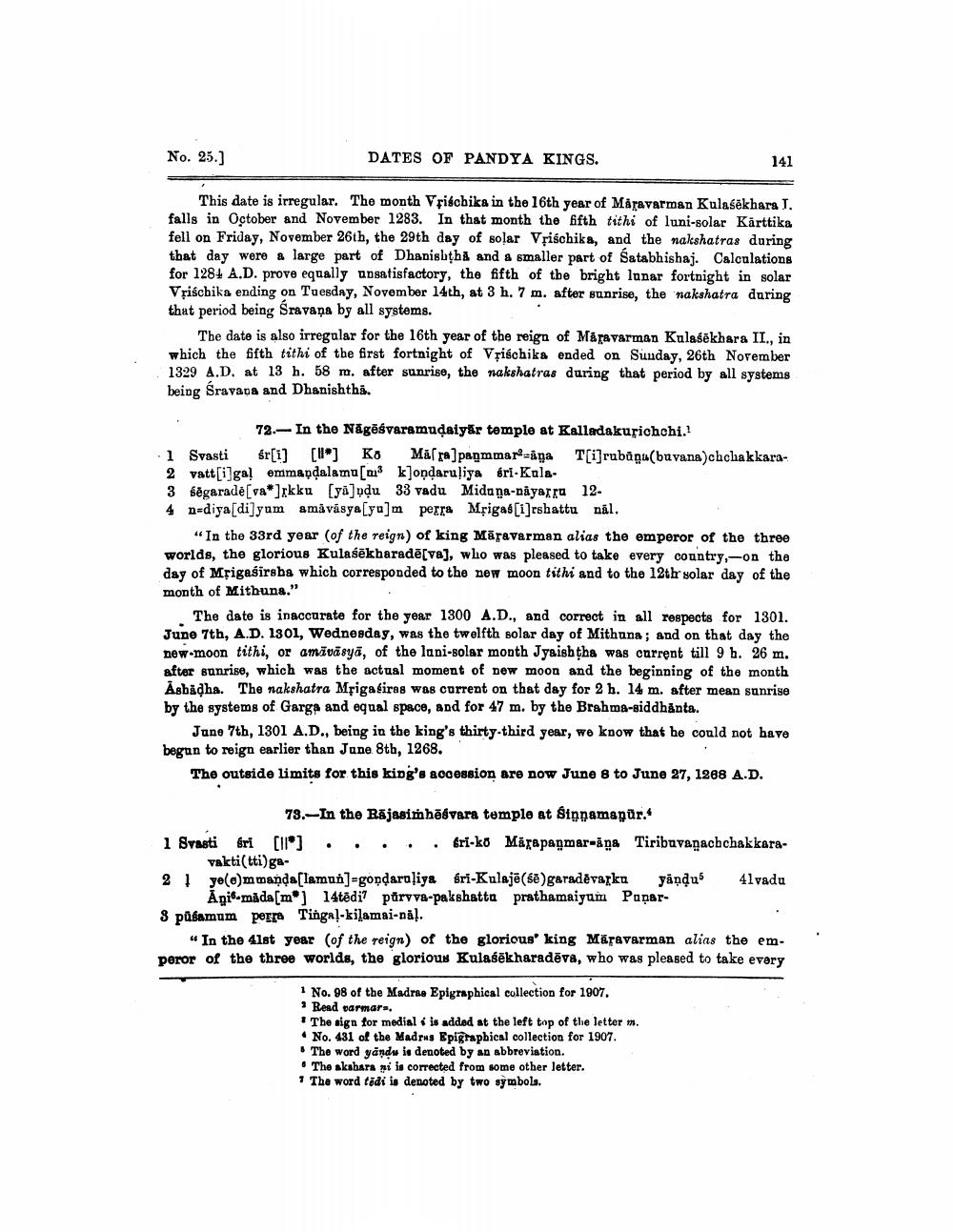________________
No. 25.]
This date is irregular. The month Vrischika in the 16th year of Maravarman Kulasekhara J. falls in October and November 1283. In that month the fifth tithi of luni-solar Kärttika fell on Friday, November 26th, the 29th day of solar Vrischika, and the nakshatras during that day were a large part of Dhanishtha and a smaller part of Satabhishaj. Calculations for 1284 A.D. prove equally unsatisfactory, the fifth of the bright lunar fortnight in solar Vrischika ending on Tuesday, November 14th, at 3 h. 7 m. after sunrise, the nakshatra during that period being Śravana by all systems.
DATES OF PANDYA KINGS.
The date is also irregular for the 16th year of the reign of Maravarman Kulasekhara II., in which the fifth tithi of the first fortnight of Vrischika ended on Sunday, 26th November 1329 A.D. at 13 h. 58 m. after sunrise, the nakshatras during that period by all systems being Śravana and Dhanishtha.
72.- In the Nägeśvaramuḍaiyar temple at Kalladakurichchi.1
1 Svasti śr[i] [*] Ko Marra]panmmar-ana
2 vatt[i]gal emmanḍalamu [m3 k]ondaruliya éri-Kala
3 segarade [va*]rkku [ya]pḍu 33 vadu Midaṇa-nāyarṛu 12
4 n=diya[di]yum amavasya [yu]m perra Mrigas[i]rshattu nāl.
1 Svasti śri
"In the 33rd year (of the reign) of king Märavarman alias the emperor of the three worlds, the glorious Kulasekharade[va], who was pleased to take every country,-on the day of Mrigasirsha which corresponded to the new moon tithi and to the 12th solar day of the month of Mithuna."
T[i]rubana(buvana)chchakkara
The date is inaccurate for the year 1300 A.D., and correct in all respects for 1301. June 7th, A.D. 1301, Wednesday, was the twelfth solar day of Mithuna; and on that day the new-moon tithi, or amavasya, of the luni-solar month Jyaishtha was current till 9 h. 26 m. after sunrise, which was the actual moment of new moon and the beginning of the month Ashadha. The nakshatra Mrigasiras was current on that day for 2 h. 14 m. after mean sunrise by the systems of Garga and equal space, and for 47 m. by the Brahma-siddhanta.
141
June 7th, 1301 A.D., being in the king's thirty-third year, we know that he could not have begun to reign earlier than June 8th, 1268.
The outside limits for this king's accession are now June 8 to June 27, 1288 A.D.
vakti (tti)ga
73.-In the Rajasimhēsvara temple at Sinnamanur. [*]
Eri-ko Magapagmar-iga Tiribavapachchakkara
2 ye(e)mmanda[laman]-goodaruliya
ri-Kulaje(66)garađērasku
yāṇḍus
Ani-mada [m] 14tedi purvva-pakshatta prathamaiyum Papar3 pūšamum perra Tingal-kilamai-nā).
"In the 41st year (of the reign) of the glorious' king Märavarman alias the emperor of the three worlds, the glorious Kulasekharadeva, who was pleased to take every
1 No. 98 of the Madras Epigraphical collection for 1907. * Read varmars.
The sign for medial is added at the left top of the letter m.
No. 431 of the Madras Epigraphical collection for 1907.
The word yandu is denoted by an abbreviation.
The akshara ni is corrected from some other letter. The word tedi is denoted by two symbols.
41vadu




